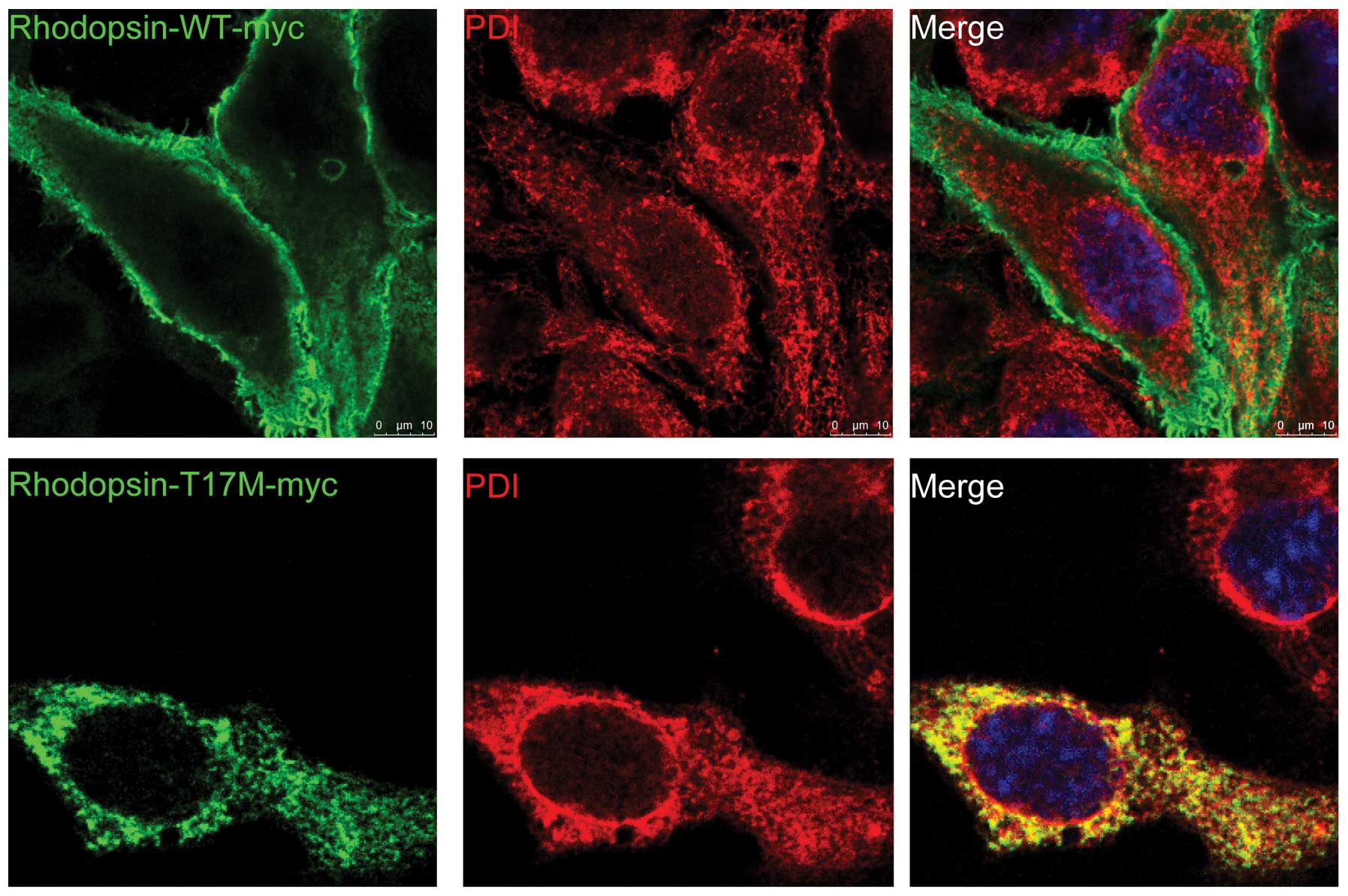|
1
|
Dryja TP, McGee TL, Hahn LB, et al:
Mutations within the rhodopsin gene in patients with autosomal
dominant retinitis pigmentosa. N Engl J Med. 323:1302–1307. 1990.
View Article : Google Scholar : PubMed/NCBI
|
|
2
|
Hartong DT, Berson EL and Dryja TP:
Retinitis pigmentosa. Lancet. 368:1795–1809. 2006. View Article : Google Scholar : PubMed/NCBI
|
|
3
|
Mendes HF, van der Spuy J, Chapple JP and
Cheetham ME: Mechanisms of cell death in rhodopsin retinitis
pigmentosa: implications for therapy. Trends Mol Med. 11:177–185.
2005. View Article : Google Scholar : PubMed/NCBI
|
|
4
|
Nathans J and Hogness DS: Isolation and
nucleotide sequence of the gene encoding human rhodopsin. Proc Natl
Acad Sci USA. 81:4851–4855. 1984. View Article : Google Scholar : PubMed/NCBI
|
|
5
|
Kaushal S and Khorana HG: Structure and
function in rhodopsin 7. Point mutations associated with autosomal
dominant retinitis pigmentosa. Biochemistry. 33:6121–6128. 1994.
View Article : Google Scholar : PubMed/NCBI
|
|
6
|
Sung CH, Davenport CM and Nathans J:
Rhodopsin mutations responsible for autosomal dominant retinitis
pigmentosa. Clustering of functional classes along the polypeptide
chain. J Biol Chem. 268:26645–26649. 1993.
|
|
7
|
Li T, Sandberg MA, Pawlyk BS, et al:
Effect of vitamin A supplementation on rhodopsin mutants
threonine-17 --> methionine and proline-347 --> serine in
transgenic mice and in cell cultures. Proc Natl Acad Sci USA.
95:11933–11938. 1998. View Article : Google Scholar : PubMed/NCBI
|
|
8
|
Jacobson SG, Kemp CM, Sung CH and Nathans
J: Retinal function and rhodopsin levels in autosomal dominant
retinitis pigmentosa with rhodopsin mutations. Am J Ophthalmol.
112:256–271. 1991. View Article : Google Scholar : PubMed/NCBI
|
|
9
|
Sung CH, Davenport CM, Hennessey JC, et
al: Rhodopsin mutations in autosomal dominant retinitis pigmentosa.
Proc Natl Acad Sci USA. 88:6481–6485. 1991. View Article : Google Scholar : PubMed/NCBI
|
|
10
|
White DA, Fritz JJ, Hauswirth WW, Kaushal
S and Lewin AS: Increased sensitivity to light-induced damage in a
mouse model of autosomal dominant retinal disease. Invest
Ophthalmol Vis Sci. 48:1942–1951. 2007. View Article : Google Scholar : PubMed/NCBI
|
|
11
|
Ridge KD, Abdulaev NG, Sousa M and
Palczewski K: Phototransduction: crystal clear. Trends Biochem Sci.
28:479–487. 2003. View Article : Google Scholar
|
|
12
|
Chapple JP, Grayson C, Hardcastle AJ,
Saliba RS, van der Spuy J and Cheetham ME: Unfolding retinal
dystrophies: a role for molecular chaperones? Trends Mol Med.
7:414–421. 2001. View Article : Google Scholar : PubMed/NCBI
|
|
13
|
Gorbatyuk MS, Knox T, LaVail MM, et al:
Restoration of visual function in P23H rhodopsin transgenic rats by
gene delivery of BiP/Grp78. Proc Natl Acad Sci USA. 107:5961–5966.
2010. View Article : Google Scholar : PubMed/NCBI
|
|
14
|
Krebs MP, White DA and Kaushal S: Biphasic
photoreceptor degeneration induced by light in a T17M rhodopsin
mouse model of cone bystander damage. Invest Ophthalmol Vis Sci.
50:2956–2965. 2009. View Article : Google Scholar : PubMed/NCBI
|
|
15
|
Krebs MP, Holden DC, Joshi P, Clark CL
III, Lee AH and Kaushal S: Molecular mechanisms of rhodopsin
retinitis pigmentosa and the efficacy of pharmacological rescue. J
Mol Biol. 395:1063–1078. 2010. View Article : Google Scholar : PubMed/NCBI
|
|
16
|
Tam BM and Moritz OL: The role of
rhodopsin glycosylation in protein folding, trafficking, and
light-sensitive retinal degeneration. J Neurosci. 29:15145–15154.
2009. View Article : Google Scholar : PubMed/NCBI
|
|
17
|
Selkoe DJ: Cell biology of protein
misfolding: The examples of Alzheimer’s and Parkinson’s diseases.
Nat Cell Biol. 6:1054–1061. 2004.
|
|
18
|
Wickner S, Maurizi MR and Gottesman S:
Posttranslational quality control: folding, refolding, and
degrading proteins. Science. 286:1888–1893. 1999. View Article : Google Scholar : PubMed/NCBI
|
|
19
|
Chaudhuri TK and Paul S:
Protein-misfolding diseases and chaperone-based therapeutic
approaches. FEBS J. 273:1331–1349. 2006. View Article : Google Scholar : PubMed/NCBI
|
|
20
|
Kunte MM, Choudhury S, Manheim JF, et al:
ER stress is involved in T17M rhodopsin-induced retinal
degeneration. Invest Ophthalmol Vis Sci. 53:3792–3800. 2012.
View Article : Google Scholar : PubMed/NCBI
|
|
21
|
Finger A, Knop M and Wolf DH: Analysis of
two mutated vacuolar proteins reveals a degradation pathway in the
endoplasmic reticulum or a related compartment of yeast. Eur J
Biochem. 218:565–574. 1993. View Article : Google Scholar : PubMed/NCBI
|
|
22
|
Zhao L and Ackerman SL: Endoplasmic
reticulum stress in health and disease. Curr Opin Cell Biol.
18:444–452. 2006. View Article : Google Scholar
|
|
23
|
Griciuc A, Aron L and Ueffing M: ER stress
in retinal degeneration: a target for rational therapy? Trends Mol
Med. 17:442–451. 2011. View Article : Google Scholar : PubMed/NCBI
|
|
24
|
Scorrano L, Oakes SA, Opferman JT, et al:
BAX and BAK regulation of endoplasmic reticulum Ca2+: a
control point for apoptosis. Science. 300:135–139. 2003. View Article : Google Scholar : PubMed/NCBI
|
|
25
|
Haynes CM, Titus EA and Cooper AA:
Degradation of misfolded proteins prevents ER-derived oxidative
stress and cell death. Mol Cell. 15:767–776. 2004. View Article : Google Scholar : PubMed/NCBI
|
|
26
|
Stefani IC, Wright D, Polizzi KM and
Kontoravdi C: The role of ER stress-induced apoptosis in
neurodegeneration. Curr Alzheimer Res. 9:373–387. 2012. View Article : Google Scholar : PubMed/NCBI
|
|
27
|
Hayashi T, Saito A, Okuno S, Ferrand-Drake
M, Dodd RL and Chan PH: Damage to the endoplasmic reticulum and
activation of apoptotic machinery by oxidative stress in ischemic
neurons. J Cereb Blood Flow Metab. 25:41–53. 2005. View Article : Google Scholar : PubMed/NCBI
|














